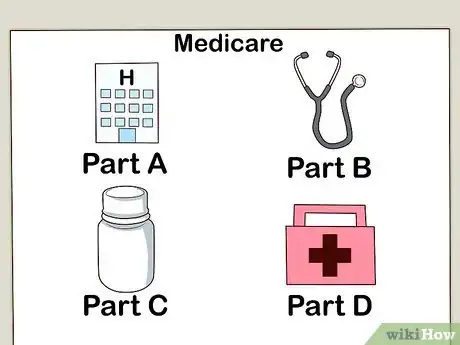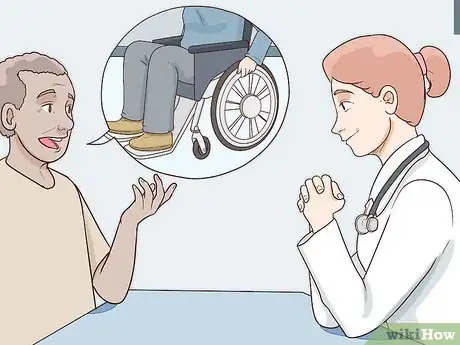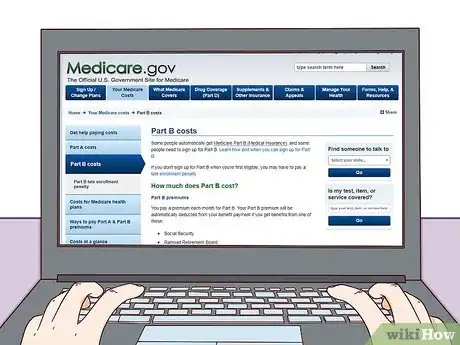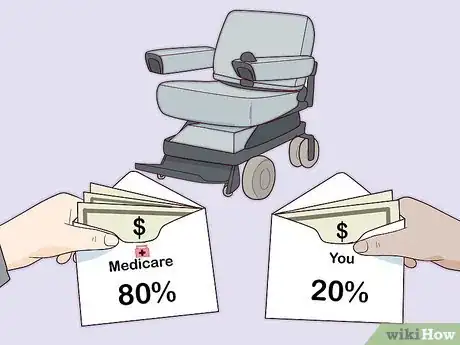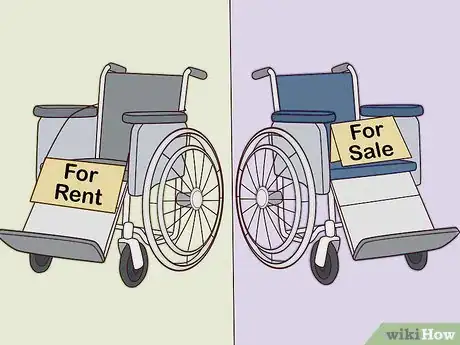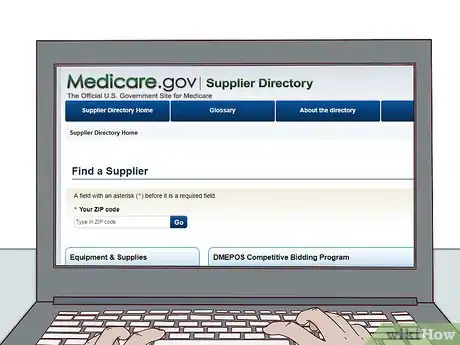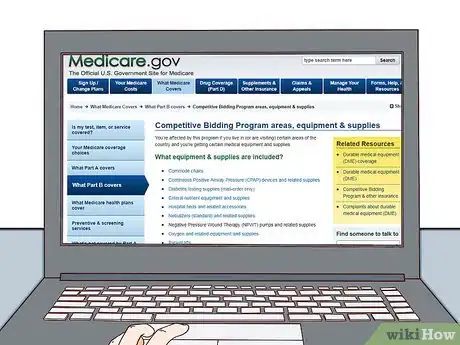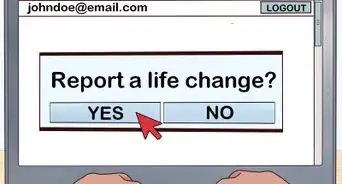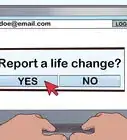wikiHow is a “wiki,” similar to Wikipedia, which means that many of our articles are co-written by multiple authors. To create this article, 9 people, some anonymous, worked to edit and improve it over time.
wikiHow marks an article as reader-approved once it receives enough positive feedback. This article received 13 testimonials and 86% of readers who voted found it helpful, earning it our reader-approved status.
This article has been viewed 196,133 times.
Learn more...
If you are on Medicare and you have suffered from a recent injury or disability, or are recovering from surgery, you might be eligible for a wheelchair benefit. Older people who find their mobility has been compromised can also try to get a wheelchair with their Medicare Part B benefits. It does not take much to get a wheelchair from Medicare, just talking to a doctor and finding the right supplier.
Steps
Getting a Certificate of Necessity
-
1Get on Medicare. If you are over the age of 65, a US citizen, and having paid into Social Security through your job for at least 10 years, you are eligible for Medicare, the government's health care insurance plan. There are 4 plans in the Medicare program (Parts A, B, C, and D), which cover different aspects of your healthcare. Find a plan that works for you, and enroll during the open enrollment periods.
- You may already be covered. Once you apply for Social Security benefits, you will be automatically enrolled in Medicare Part A, which covers hospital care, and Part B, which covers medical services and supplies. These two parts together are sometimes called "Original Medicare."
- Part C, a healthcare insurance plan, and Part D, the prescription drug plan, require separate applications. They don't have anything to do with getting a wheelchair, so no need to worry about them here.
-
2Schedule a doctor's appointment. Medicare will require a signed Certificate of Necessity from a doctor for your wheelchair. Your doctor will need to determine that you meet the necessary conditions to receive Medicare support.Advertisement
-
3Explain to your doctor why you need a wheelchair. Explain the specific issues you are having or tasks you cannot perform as a result of your condition. Provide your doctor with as much detail as possible in your answers. You will also want to be sure that a wheelchair will solve your issues, and not some other piece of equipment, like a cane, crutches, or a walker.
- Tasks that you cannot do along can be simple, everyday tasks. If you have trouble bathing, getting dressed, or using the bathroom, even with help, these are all acceptable reasons for needing medical equipment.
-
4Make sure you will be able to operate the wheelchair safely. A wheelchair is a substantial piece of equipment, and one that will take some time to use properly. You will need to be able to get in and out of the chair, as well as maneuver it around your home.
- If you cannot do this on your own, then you will need help. You may need to find an assistant, whether a family member or professional nurse, to help you safely use your wheelchair.
-
5Decide on the wheelchair that is best for you. The Certificate of Necessity will have to note the type of wheelchair you need. In general, there are three different types of wheelchairs: a manual wheelchair, power-operated vehicle, or power wheelchair.
- A manual wheelchair is powered by you or someone else pushing it. If you have enough upper body strength to maneuver the chair, or you have someone able to push you around, you can qualify for a manual wheelchair.
- To qualify for a power-operated vehicle, or scooter, you need to demonstrate the strength and ability to sit up and operate the controls safely. You will also need to be able to get in and out of the vehicle safely, whether by yourself or with help.
- If you can't use a manual wheelchair, or don't qualify for a power-operated scooter because you cannot sit up or work the controls safely, you might qualify for a power wheelchair. Your doctor will need to give you a face-to-face exam in order to submit the written order.
- Consider other features, such as folding easily to get in and out of the car. Determine whether you will be using your wheelchair indoors or outdoors (or both), and how many hours in the day you will be using it.
-
6Get the signed Certificate of Necessity. Once you have demonstrated need to your doctor, and decided upon the proper wheelchair for you, he or she can sign the necessary certificate, and get you on your way to a wheelchair or scooter.
Getting Your Wheelchair
-
1Check to make sure you have met your Part B deductible. Medicare will not pay for the wheelchair until you have met your deductible. In 2015, the deductible is $147.[1] This means you must have paid at least $147 of out-of-pocket medical expenses before the Medicare Part B coverage is applied to your wheelchair.
- The deductible can change every year, so make sure you have the most up-to-date information from Medicare, either through official paperwork they send you, or through their website: https://www.medicare.gov/your-medicare-costs/index.html.
-
2Know how much you are going to pay. Medicare will help cover your expenses, but it won't make the wheelchair free in most cases. Assuming you meet the deductible, Medicare Part B will cover 80 percent of the wheelchair cost, meaning you will pay 20 percent.
- If you are unable to pay that 20 percent, you may be able to get additional assistance through the Medicare Savings Program. Payments are different in each state, so you will need to contact your state office to find out if you qualify, and how much money you can receive.[2]
-
3Determine whether you should rent or buy your wheelchair. Rental can be cheaper in the short term, so you may choose to rent, rather than buy, your wheelchair. If you rent, Medicare will cover rental costs for up to 13 months. After 13 months, you will own the equipment. If you expect to use the wheelchair for a long time, buying up front may be cheaper after you account for a deposit and the rental payments.
- You should discuss the length of time you will need the wheelchair with your doctor, while you can discuss the payment options with the medical supplier.
-
4Find a supplier approved by Medicare. Medicare will only pay for costs that they approve, so purchase your wheelchair at a medical supply store that is approved by Medicare. You can find those stores either by calling Medicare directly at 1-800-MEDICARE (1-800-633-4227) or searching through their online directory at https://www.medicare.gov/SupplierDirectory/. You are looking for a supplier that sells Durable Medical Equipment (DME).
-
5See if you are eligible for Medicare's Competitive Bidding Program. In certain parts of the country, Medicare will have suppliers submit bids to provide medical items, like wheelchairs, as a lower price.
- This only applies for sure if you are covered under Original Medicare (Parts A and B). If you are enrolled in Part C, a Medicare Advantage Plan (such as an HMO or PPO), you will need to check with your plan to see if it is involved with the Competitive Bidding Program.
-
6Contact a supplier. Once you have your Certificate of Necessity, call the company you want to purchase from within 45 days. They will send a representative to your house to measure and make sure you are getting the right model.[3] Once you have picked out the right chair, the supplier will make arrangements for delivery and payment.
Warnings
- Be cautious about fraudulent doctors and providers who attempt to offer high cost wheelchairs to people who do not qualify for them. If you are offered a free wheelchair, or a company wants to waive your copayment, you may be dealing with a dishonest provider. You should also be suspicious if you receive a bill for equipment you never received. If you suspect fraud, call 1-800-MEDICARE (1-800-633-4227).⧼thumbs_response⧽
- Remember to make safety a priority. Using a wheelchair may take some time, so practice using it while family members or friends are close by and can help you if you get stuck or run into problems.⧼thumbs_response⧽
References
About This Article
If you’re on Medicare and want to get a wheelchair, first make an appointment with your doctor to get a signed certificate of necessity. At your appointment, explain to your doctor the activities you can’t do due to your condition and why a wheelchair would help. Be as detailed as you can, since this will help the doctor decide whether they can support your request. Discuss with your doctor whether you need a manual wheelchair, which you’ll need to power with your upper body or have someone push you, or a power-operated vehicle, which you’ll operate yourself with a control panel. Once you’ve got the signed certificate, make sure you’ve already paid your part B deductible, since Medicare won’t pay for your wheelchair until you do. Finally, choose a wheelchair from a Medicare-approved supplier, which you’ll find on the Medicare website. For tips on how to decide whether to rent or buy your wheelchair, keep reading!
